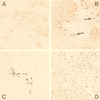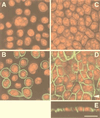MRP3, an organic anion transporter able to transport anti-cancer drugs
- PMID: 10359813
- PMCID: PMC22016
- DOI: 10.1073/pnas.96.12.6914
MRP3, an organic anion transporter able to transport anti-cancer drugs
Abstract
The human multidrug-resistance protein (MRP) gene family contains at least six members: MRP1, encoding the multidrug-resistance protein; MRP2 or cMOAT, encoding the canalicular multispecific organic anion transporter; and four homologs, called MRP3, MRP4, MRP5, and MRP6. In this report, we characterize MRP3, the closest homolog of MRP1. Cell lines were retrovirally transduced with MRP3 cDNA, and new monoclonal antibodies specific for MRP3 were generated. We show that MRP3 is an organic anion and multidrug transporter, like the GS-X pumps MRP1 and MRP2. In Madin-Darby canine kidney II cells, MRP3 routes to the basolateral membrane and mediates transport of the organic anion S-(2,4-dinitrophenyl-)glutathione toward the basolateral side of the monolayer. In ovarian carcinoma cells (2008), expression of MRP3 results in low-level resistance to the epipodophyllotoxins etoposide and teniposide. In short-term drug exposure experiments, MRP3 also confers high-level resistance to methotrexate. Neither 2008 cells nor Madin-Darby canine kidney II cells overexpressing MRP3 showed an increase in glutathione export or a decrease in the level of intracellular glutathione, in contrast to cells overexpressing MRP1 or MRP2. We discuss the possible function of MRP3 in (hepatic) physiology and its potential contribution to drug resistance of cancer cells.
Figures





Similar articles
-
Transport of amphipathic anions by human multidrug resistance protein 3.Cancer Res. 2000 Sep 1;60(17):4779-84. Cancer Res. 2000. PMID: 10987286
-
Analysis of expression of cMOAT (MRP2), MRP3, MRP4, and MRP5, homologues of the multidrug resistance-associated protein gene (MRP1), in human cancer cell lines.Cancer Res. 1997 Aug 15;57(16):3537-47. Cancer Res. 1997. PMID: 9270026
-
Characterization of the human multidrug resistance protein isoform MRP3 localized to the basolateral hepatocyte membrane.Hepatology. 1999 Apr;29(4):1156-63. doi: 10.1002/hep.510290404. Hepatology. 1999. PMID: 10094960
-
[Analysis of xenobiotic detoxification system mediated by efflux transporters].Yakugaku Zasshi. 1999 Nov;119(11):822-34. doi: 10.1248/yakushi1947.119.11_822. Yakugaku Zasshi. 1999. PMID: 10590710 Review. Japanese.
-
Do cMOAT (MRP2), other MRP homologues, and LRP play a role in MDR?Semin Cancer Biol. 1997 Jun;8(3):205-13. doi: 10.1006/scbi.1997.0071. Semin Cancer Biol. 1997. PMID: 9441949 Review.
Cited by
-
Effect of nine diets on xenobiotic transporters in livers of mice.Xenobiotica. 2015;45(7):634-41. doi: 10.3109/00498254.2014.1001009. Epub 2015 Jan 8. Xenobiotica. 2015. PMID: 25566878 Free PMC article.
-
Apical/basolateral surface expression of drug transporters and its role in vectorial drug transport.Pharm Res. 2005 Oct;22(10):1559-77. doi: 10.1007/s11095-005-6810-2. Epub 2005 Sep 22. Pharm Res. 2005. PMID: 16180115 Review.
-
Interdependence of gemcitabine treatment, transporter expression, and resistance in human pancreatic carcinoma cells.Neoplasia. 2010 Sep;12(9):740-7. doi: 10.1593/neo.10576. Neoplasia. 2010. PMID: 20824050 Free PMC article.
-
Resveratrol Targets a Variety of Oncogenic and Oncosuppressive Signaling for Ovarian Cancer Prevention and Treatment.Antioxidants (Basel). 2021 Oct 28;10(11):1718. doi: 10.3390/antiox10111718. Antioxidants (Basel). 2021. PMID: 34829589 Free PMC article. Review.
-
Impaired clearance of methotrexate in organic anion transporter 3 (Slc22a8) knockout mice: a gender specific impact of reduced folates.Pharm Res. 2008 Feb;25(2):453-62. doi: 10.1007/s11095-007-9407-0. Epub 2007 Jul 28. Pharm Res. 2008. PMID: 17660957 Free PMC article.
References
-
- Gottesman M M, Pastan I, Ambudkar S V. Curr Opin Genet Dev. 1996;6:610–617. - PubMed
-
- Cole S P C, Deeley R G. BioEssays. 1998;20:931–940. - PubMed
-
- Leier I, Jedlitschky G, Buchholz U, Cole S P C, Deeley R G, Keppler D. J Biol Chem. 1994;269:27807–27810. - PubMed
-
- Jedlitschky G, Leier I, Buchholz U, Barnouin K, Kurz G, Keppler D. Cancer Res. 1996;56:988–994. - PubMed
-
- Zaman G J R, Cnubben N H P, van Bladeren P J, Evers R, Borst P. FEBS Lett. 1996;391:126–130. - PubMed
Publication types
MeSH terms
Substances
Associated data
- Actions
LinkOut - more resources
Full Text Sources
Other Literature Sources
Molecular Biology Databases
Research Materials

